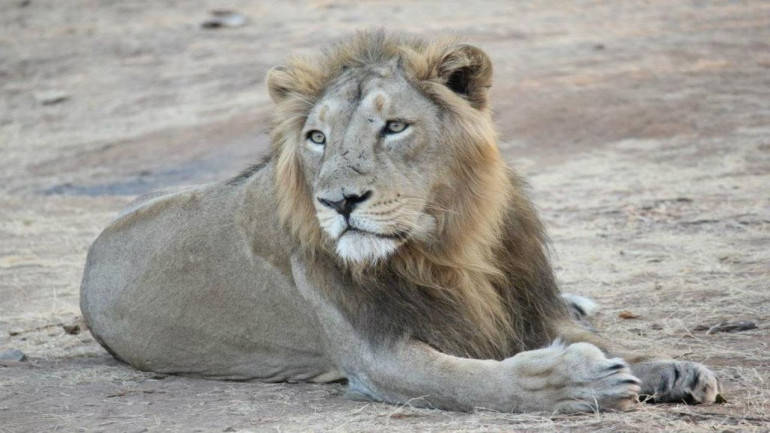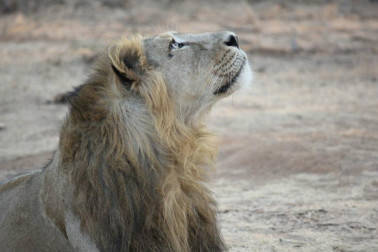The sanctuary has enough wildlife to keep you occupied even if you’re not lucky to see a lion.

By Venkat Ganesh
Imagine this. As you enter the jungle to look at the famed Asiatic lions on a misty morning in an open air jeep, the crisp winter air bites you. Your eyes begin to water and your ears begin to go numb due to the cool air. And yet your senses are on the lookout for any movements from bushes on both sides of the dusty track or some sounds from canopy above warning of the presence of a predator.
All of a sudden your forest guide asks the driver to stop and warns you not to get off the vehicle as he gets downs. He bends down and points his fingers at the pug marks on the dirt road. A look at them for a few seconds and he can tell the animals gender, the number of them in the pride, their age and how many minutes ago the pride would’ve passed by. He follows the footprints a few feet down the road and then climbs back into the vehicle but this time asking the driver to follow the pug marks and drive slow.
A few hundred meters (or a couple of kilometers) down the track he asks the driver to kill the engine. He has spotted a pride of lionesses and cubs. You’re still struggling to see them among the bushes, camouflaged well but he can. And then you see them as well. It as he had told you to expect. A chill runs down your spine. Especially when it’s the first big cat that you’ve seen in a wild.
Though not as big in size or possessing as lustrous mane as its African sibling, the Asiatic lion does not lack in majesty. And having almost gone to the brink of extinction due to relentless game hunting in the first half of 1900s, the lion population made a revival due to conservation efforts of the royal family of Junagad, the local tribes and the forest department. Today there are more than 400 of them and growing.

Located at an hour’s drive from Junagadh, Gir National Forest is the only abode of the Asiatic lions in the world. However, the national part is not just home to lions but also to more than 300 leopards, 200 species of birds, and numerous animals, reptiles and amphibians.
The sanctuary has enough wildlife to keep you occupied even if you’re not lucky to see a lion. The best times to spot maximum wildlife, the guides advice are the months of summer when all the animals come to the watering holes to have their quench their thirst. However, the cooler months February and March are much better if you can’t bear the heat.
And not just other wild animals, for centuries humans have co-existed with the lions in this part of the world. The Maaldharis are semi nomadic herdsmen tribe and still continue to live in small scattered settlements throughout the national park. Being cattle herders, living in a land of lions can be dangerous and ever so often they lose an animal to the bug cats. But they think of it as nothing more than an offering to the Gods who have taken their share for all they have offered to the tribe by giving them everything they need in the jungle. In fact a few of the government appointed guides themselves are from the maaldhari tribel and they play a huge rule in the conservation of the Asiatic lions.
Wildlife enthusiasts can enter the sanctuary in one or all of the 3 three hour slots of the day. The first of the slot is the 6am-9am slot, followed by the 9am to 12pm and then the final set of jeeps are allowed to enter the sanctuary at 3pm in the afternoon.
The access to the sanctuary is by permit only which cost Rs 500 per 4 wheeler. For those who don’t have their own mode of transport, the forest department provides a jeep with a driver which is another Rs1200. Along with the permit having a guide is mandatory and costs another 500. If you’re in a group, it is possible to share all these costs otherwise a single trip to catch a glimpse of the big cat can turn out to be an expensive affair at Rs 2200.
In a country like India which is full of tiger reserves, it’s definitely worth a visit to the lion country of Sasan Gir to know for yourself why it is called King of the Jungle.
Imagine this. As you enter the jungle to look at the famed Asiatic lions on a misty morning in an open air jeep, the crisp winter air bites you. Your eyes begin to water and your ears begin to go numb due to the cool air. And yet your senses are on the lookout for any movements from bushes on both sides of the dusty track or some sounds from canopy above warning of the presence of a predator.
All of a sudden your forest guide asks the driver to stop and warns you not to get off the vehicle as he gets downs. He bends down and points his fingers at the pug marks on the dirt road. A look at them for a few seconds and he can tell the animals gender, the number of them in the pride, their age and how many minutes ago the pride would’ve passed by. He follows the footprints a few feet down the road and then climbs back into the vehicle but this time asking the driver to follow the pug marks and drive slow.
A few hundred meters (or a couple of kilometers) down the track he asks the driver to kill the engine. He has spotted a pride of lionesses and cubs. You’re still struggling to see them among the bushes, camouflaged well but he can. And then you see them as well. It as he had told you to expect. A chill runs down your spine. Especially when it’s the first big cat that you’ve seen in a wild.
Though not as big in size or possessing as lustrous mane as its African sibling, the Asiatic lion does not lack in majesty. And having almost gone to the brink of extinction due to relentless game hunting in the first half of 1900s, the lion population made a revival due to conservation efforts of the royal family of Junagad, the local tribes and the forest department. Today there are more than 400 of them and growing.

Located at an hour’s drive from Junagadh, Gir National Forest is the only abode of the Asiatic lions in the world. However, the national part is not just home to lions but also to more than 300 leopards, 200 species of birds, and numerous animals, reptiles and amphibians.
The sanctuary has enough wildlife to keep you occupied even if you’re not lucky to see a lion. The best times to spot maximum wildlife, the guides advice are the months of summer when all the animals come to the watering holes to have their quench their thirst. However, the cooler months February and March are much better if you can’t bear the heat.
And not just other wild animals, for centuries humans have co-existed with the lions in this part of the world. The Maaldharis are semi nomadic herdsmen tribe and still continue to live in small scattered settlements throughout the national park. Being cattle herders, living in a land of lions can be dangerous and ever so often they lose an animal to the bug cats. But they think of it as nothing more than an offering to the Gods who have taken their share for all they have offered to the tribe by giving them everything they need in the jungle. In fact a few of the government appointed guides themselves are from the maaldhari tribel and they play a huge rule in the conservation of the Asiatic lions.
Wildlife enthusiasts can enter the sanctuary in one or all of the 3 three hour slots of the day. The first of the slot is the 6am-9am slot, followed by the 9am to 12pm and then the final set of jeeps are allowed to enter the sanctuary at 3pm in the afternoon.
The access to the sanctuary is by permit only which cost Rs 500 per 4 wheeler. For those who don’t have their own mode of transport, the forest department provides a jeep with a driver which is another Rs1200. Along with the permit having a guide is mandatory and costs another 500. If you’re in a group, it is possible to share all these costs otherwise a single trip to catch a glimpse of the big cat can turn out to be an expensive affair at Rs 2200.
In a country like India which is full of tiger reserves, it’s definitely worth a visit to the lion country of Sasan Gir to know for yourself why it is called King of the Jungle.
http://www.moneycontrol.com/news/trends/travel-trends/gir-national-forest-abode-of-asiatic-lion-in-the-world-2284651.html
No comments:
Post a Comment